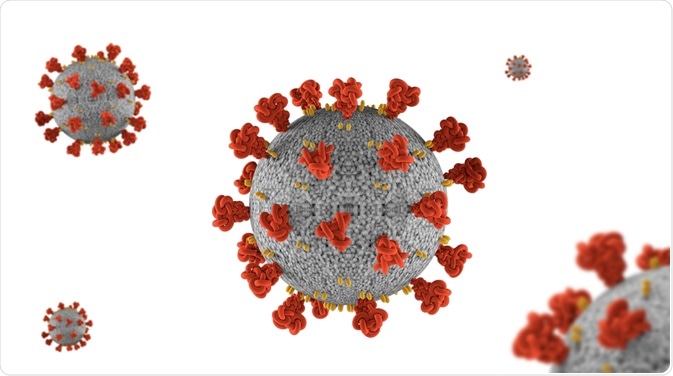Viral load refers to the amount of virus in an infected person’s blood. This is expressed as the number of viral particles in each milliliter of blood. Higher viral load can have different implications for different viruses but typically means the infection is progressing.

Image Credit: Jarun Ontakrai/Shutterstock.com
Viral load and how it is measured
Viral load tests measure the quantity of genetic material, commonly RNA, of a virus present in the blood. Several tests are typically done over an extended period, with initial measurements serving as the baseline and subsequent measurements compared to this.
Viral load measurements can differ daily, and therefore long-term trends are used to evaluate disease progression.
There are three main tests used to measure viral load. These are reverse transcription-polymerase chain reaction (RT-PCR) tests, branched DNA (bDNA) tests, and nucleic acid sequence-based amplification (NASBA) tests. These tests report viral load results differently, which means it is crucial to be consistent in the test used throughout the monitoring.
Regardless, viral load tests should be able to consistently measure levels of viruses down to 50 copies per 1 mL. They also need to have high specificity for the target virus and have reproducible, and therefore comparable, results.
How to interpret viral load measurements
As viral load increases, the disease is seen as progressing. However, if measurements show the viral load decreasing over several individual testing occasions, the infection is interpreted as being suppressed. Monitoring viral load throughout an infection can also show how well if at all, a patient is responding to treatment.
Viral load measurements can be critically important in the treatment of certain diseases. For example, a high viral load of HIV-1 viral particles is associated with an increased rate of CD4+ T cell destruction and thus faster progression towards AIDS. The goal of treating HIV infections is by keeping CD4+ T cell counts high and viral load low, and as such the viral load is crucial when deciding to start anti-viral treatment.
The viral load has, and still can be, a common way in which other viral parameters are determined. Reproductive number (R0) and the life span of an infected cell can be difficult to measure directly but can be estimated by fitting different mathematical models to data on viral load. However, some serious drawbacks have been identified with these methods.
For example, the reproductive number can be underestimated based on model assumptions, such as neglecting the process of intracellular decay which occurs before the reproduction of the virion. For cell life span, many of these models assume that any treatment occurring is perfect and fully stops viral replication, which is not an accurate reflection of reality.
These models will overestimate the life span of an infected cell. Models also tend to assume basic models can describe viral parameters at any point of the infection, whereas parameters such as cell life span can differ drastically at the start of an infection and once an equilibrium is reached.
Viral load and COVID-19
Most of the previous research on viral loads has focused on HIV, partly because it is a close link to the disease progression and because HIV is one of the highest-profile viral infections. Recent research efforts have focused on COVID-19 and the viral load of SARS-CoV-2, but this research is still new.
The causative virus of COVID-19 is closely related to SARS-CoV, which caused an epidemic in the early 2000s. SARS-CoV viral loads grew from initially modest viral loads in the respiratory tracts. In contrast to this, SARS-CoV-2 viral loads appear to be higher in the nose than in the throat.
Research on the SARS-CoV virus also showed that viral loads peaked 10-14 days after symptoms first appeared. In SARS-CoV-2, the highest viral load appears to be earlier, within the first week of symptom onset.
This is more consistent with the pattern seen in influenza, rather than SARS-CoV. This also implies that the potential for transmission is high early on in the infection of SARS-CoV-2, which has serious implications for disease spread management.
Viral loads in COVID-19 patients have also been found in asymptomatic patients. These have been similar to those of symptomatic patients, which suggests they have a similar ability to transmit the infection. It has been shown that asymptomatic individuals can pass on the disease, which is part of what has made COVID-19 so easily transmissible.
More data and a better understanding of how viral load correlates with a culture-viable virus are needed to further determine transmission dynamics and advise screening practices.

Image Credit: GEMINI PRO STUDIO/Shutterstock.com
References
- Cevik, M. et al. (2020). SARS-CoV-2, SARS-CoV, and MERS-CoV viral load dynamics, duration of viral shedding, and infectiousness: a systematic review and meta-analysis. The Lancet Microbe, 2(1), E13-E22.
- Lloyd, A., 2001. The dependence of viral parameter estimates on the assumed viral life cycle: limitations of studies of viral load data. Proceedings of the Royal Society of London. Series B: Biological Sciences, 268(1469), pp.847-854.
- Thompson, E., Husney, A., and Shalit, P., 2020. HIV Viral Load Measurement. [online] Uofmhealth.org. Available at: <https://www.uofmhealth.org/health-library/tu6396>.
- Who.int. 2020. Viral Load Testing. [online] Available at: https://www.who.int/.
- Zou, L., Ruan, F., Huang, M., Liang, L., Huang, H., Hong, Z., Yu, J., Kang, M., Song, Y., Xia, J., Guo, Q., Song, T., He, J., Yen, H., Peiris, M. and Wu, J., 2020. SARS-CoV-2 Viral Load in Upper Respiratory Specimens of Infected Patients. New England Journal of Medicine, 382(12), pp.1177-1179.
Further Reading